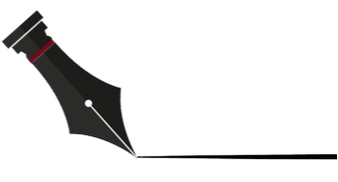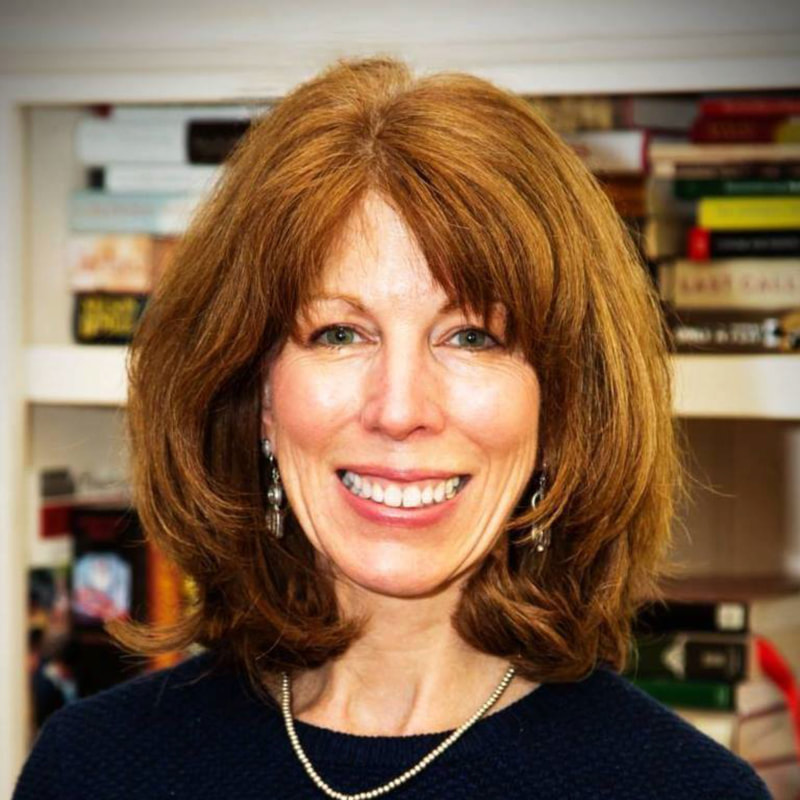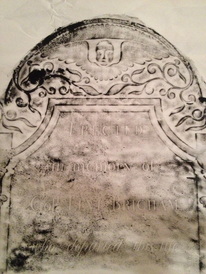 Col. Levi Brigham (d.1787) Col. Levi Brigham (d.1787) Taking a break from my inside job, I went on another field trip of sorts to a gravestone rubbing workshop offered by the Gravestone Girls at a local cemetery. What was different about this trip was that it wasn't important WHO was there but WHAT . If you live in New England, chances are pretty darned good that somewhere in your town is a very old, and possibly neglected, early colonial burial ground. It is there that your earliest settlers buried their families quickly and went back to the task of survival in the wild new land. The cemeteries of that era are not particularly inviting and pretty, but within that utilitarian piece of historical land is an amazing amount of art and poetry. If you have ever had the chance to wander the landscape of an old burial place and read a few inscriptions, you know exactly what I mean. One headstone in the Howard Street Old Burial Ground (Northborough, MA) for a town hero who fought in the War of the Revolution, is inscribed as follows: ERECTED in memory of Colonel LEVI BRIGHAM, who departed this life February 1st 1787 : Aged 70 Years.
There were several common symbols chosen by families to express a specific message regarding the passing of their loved ones. For example, the artwork of the capstone for Col. Brigham includes an angel (the wings are a dead giveaway...pun intended), which was the symbol of the messenger between man and God. Additionally, the text added to the stone often provided insight into the character or demeanor of the deceased, offering a message for the living to heed as they headed toward their own Judgement Day. Iconography of these early stones is very interesting, and more information can be found at The Association for Gravestone Studies.
Gravestone rubbings serve many purposes, depending on what interests you. The image of a stone is like a photograph, documenting the genealogical information about an ancestor. Or you might find the iconography or inscription interesting and want to preserve it as a objet d'art. With specific care and methods, a rubbing can be done without harming the original stone, and some common sense and a little homework ahead of time can help make your project a success. (Tip from the workshop: place a sheet of plastic or plastic bag over the surface of the stone and secure with masking tape prior to applying the paper layer. This protects the stone from the rubbing medium accidentally touching the stone through a tear in the paper.) The rubbing in the photo above, while not done by me personally, was given to me at the end of the workshop. The Brigham gentleman that belongs to this stone was a soldier in the War of the Revolution and descendant of the town's first settler, John Brigham. What made the gift special? The artist who thoughtfully let me take her debut work home is also a Mrs. Brigham ...from the same family who has lived in the town of Northborough from day 1. To me, she is my new local hero. And you can now understand more why I truly love "Finding New Stories in Old Places!"
1 Comment
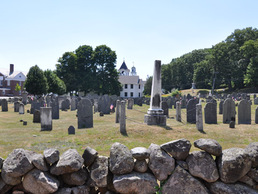 Revolutionary War Cemetery Revolutionary War Cemetery Sudbury, MA - I braved the threat of the incoming “snowstorm of the season” this afternoon to go check out the Revolutionary War Cemetery in Sudbury, MA, established in 1716. It is the oldest cemetery of modern Sudbury and holds the remains of 47 soldiers who fought in the Revolutionary War. Also buried there are Revolutionary era leaders and historical figures, such as Colonel Ezekiel How, second innkeeper of the historic Wayside Inn. The oldest existing stone is from 1727 and if you are interested, a list of the names on the stone markers is available from the Historical Society. My quest today was to move along the trail of John Brigham (1644-1728) in hopes of finding clues about his burial. My John Brigham, as I have learned, was not only the pioneer settler of what is now Northborough, MA but also a prominent settler of nearby towns Marlborough and Sudbury. When he died in 1728, he had been a long-time resident of Sudbury, but was also reported to have stayed with his daughter Mary (Brigham) Fay in Northborough. As none of the three towns has a burial record for our John Brigham, where did he go? His church membership and death were recorded in Sudbury, so that is where I headed to find a clue or two.  Footstone for M.B. Footstone for M.B. I located only two headstones in the burial ground for Brigham, neither of which was for John or one of his 3 (yes, 3) wives. Located at opposite ends of the property, they were possibly infant brother and adult sister. Curiously enough, the burial for the adult Mary Brigham is located at the end of a row that has a large gap between it and the next marker, a small footstone engraved “M.B.” 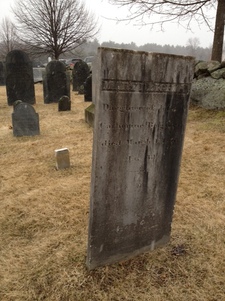 Headstone for Mary Brigham Headstone for Mary Brigham Now whether or not the little footstone belongs to Mary is difficult to tell, particularly as there is a relatively generic footstone already located behind her headstone, but no matter. What does matter is that this cemetery is arranged with many “family groups” where headstones with the same surname take up a row or two. In a small historic cemetery such as this, with closely placed burials in neatly arranged rows, any “empty” spaces are quite possibly unmarked graves where the stones fell and were buried under the sod over time. As serendipity would have it, the property has a Ground Penetrating Radar project planned for it this year and the goal will be to identify probable unmarked burials. At the end of my visit, the snow started falling and my inked notes started to bleed…but before heading home, I felt I had discovered a possible burying place for members of the Brigham family that lived during the time of my John Brigham. That alone made it a good day at work. You can find the photos and transcriptions of the Brigham headstones at www.billiongraves.com. A virtual tour of historic Sudbury is available on the town's Historical Society website. Source:
Allen, Rev. Joseph. History of Northborough, Mass., in Various Publications and Discourses. Worcester: 1880. RECORDS SEARCH IN PROGRESS..."Who was the first settler in Northborough and what's his story?"JOHN BRIGHAM (1644-1728): We know who the first settler was, both from tradition and court records, but I want to know more about the circumstances that brought him here and what happened to his family. One of the Town Proprietors in 1744 was a Brigham and a family relationship should be confirmed or ruled out. (HINT: There's not a direct line between John and Jesse, but they are actually related.)
BIOGRAPHICAL BACKGROUND: John Brigham's father Thomas came to Watertown from England when he was 34. He eventually settled in Cambridge, where all his children, including our John, were born. After Thomas' death, his widow married a Sudbury man who, with his new family, signed on to be one of those first settlers of the Marlborough Plantation. John grew up as a Marlborough man, had a well-respected career as a multi-tasking pioneer, and became the very first inhabitant on the land that became modern Northborough. His story is colorful enough that I have been purposely distracted from the Brigham Street to-do list. Truthfully, though, understanding John Brigham's life circumstances will give us insight into what happened to his family and what life was like for his descendants that stayed here. His daughters may be mothers of children buried at Brigham Street and their stories should be uncovered as well. CURRENTLY READING: Every Day Life in the Massachusetts Bay Colony by George Francis Dow (Dover Publications, New York, 1988) SOURCE: Brigham, Willard Irving Tyler. The History of the Brigham Family : a Record of Several Thousand Descendants of Thomas Brigham the Emigrant, 1603-1653. New York: Grafton Press, 1907-1927. SITE VISIT IMPRESSIONSToday's weather? No snow on the ground, ground dry, skies sunny...a perfect day to walk the Brigham Street Burial Ground since beginning this project. It seemed like the perfect opportunity to visit the site, armed with a sketch of its history and of who may be interred there. With the objectivity of a researcher, but my personal curiosity of getting a new impression of the place, I headed over and started walking a grid.
And that is where the experience got tricky. Having read about burial customs of the times, having found a witness's documentation of more burials in addition to the 4 still there, and understanding the family and neighbor relationships that existed about 1730, I "saw" so much more in that patch of land than I ever would have thought. The parcel was cleaned up and cleared before the winter, so the ground was completely exposed and easily walked. The Holloway/Wheeler family members are still where I remembered, of course. Each of the parallel and west-facing graves is still well-marked with head and footstone, the roughly 5ft by 2ft mound between the stones smattered with large rocks among the moss. This time, however, I stood back away from that small section in order to really observe the larger area nearby with a new perspective. And that is when it struck me. There are even more groupings of parallel patches of stones, some mounded and some sunken. There are even a few parallel sunken spots near the rear of the parcel. All these are not news, of course, as the observations have been made by others in the past. For me, however, to have a researched to date a count of close to 20 possible burials and to be able to count at least that number of visible marked spots left me stunned, frankly. I was also saddened by the understanding that they have been long since forgotten, except by those who maintain the property to keep it clean and mowed. There have been several efforts in the past to identify those buried there. My very non-scientific hope is that the advances made in technology over the last several decades, coupled with the advances of the information age, can shed new light on just what the story is in this interesting old place. And which of the brave founding families should be remembered and honored. |
AuthorBeth Finch McCarthy
|

